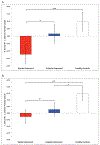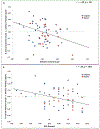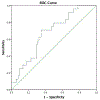Functional Connectivity Between Anterior Insula and Key Nodes of Frontoparietal Executive Control and Salience Networks Distinguish Bipolar Depression From Unipolar Depression and Healthy Control Subjects
- PMID: 29580768
- PMCID: PMC6467478
- DOI: 10.1016/j.bpsc.2018.01.013
Functional Connectivity Between Anterior Insula and Key Nodes of Frontoparietal Executive Control and Salience Networks Distinguish Bipolar Depression From Unipolar Depression and Healthy Control Subjects
Abstract
Background: Patients with bipolar depression are characterized by dysregulation across the full spectrum of mood, differentiating them from patients with unipolar depression. The ability to switch neural resources among the default mode network, salience network, and executive control network (ECN) has been proposed as a key mechanism for adaptive mood regulation. The anterior insula is implicated in the modulation of functional network switching. Differential connectivity between anterior insula and functional networks may provide insights into pathophysiological differences between bipolar and unipolar mood disorders, with implications for diagnosis and treatment.
Methods: Resting-state functional magnetic resonance imaging data were collected from 98 subjects (35 unipolar, 24 bipolar, and 39 healthy control subjects). Pearson correlations were computed between bilateral insula seed regions and a priori defined target regions from the default mode network, salience network, and ECN. After r-to-z transformation, a one-way multivariate analysis of covariance was conducted to identify significant differences in connectivity between groups. Post hoc pairwise comparisons were conducted and Bonferroni corrections were applied. Receiver-operating characteristics were computed to assess diagnostic sensitivity.
Results: Patients with bipolar depression evidenced significantly altered right anterior insula functional connectivity with the inferior parietal lobule of the ECN relative to patients with unipolar depression and control subjects. Right anterior insula-inferior parietal lobule connectivity significantly discriminated patients with bipolar depression.
Conclusions: Impaired functional connectivity between the anterior insula and the inferior parietal lobule of the ECN distinguishes patients with bipolar depression from those with unipolar depression and healthy control subjects. This finding highlights a pathophysiological mechanism with potential as a therapeutic target and a clinical biomarker for bipolar disorder, exhibiting reasonable sensitivity and specificity.
Keywords: Bipolar depression; Frontoparietal; Functional network connectivity; Insula; Salience; Unipolar depression.
Copyright © 2018 Society of Biological Psychiatry. Published by Elsevier Inc. All rights reserved.
Conflict of interest statement
Financial Disclosures
No commercial funding to any contributing authors directly supported the preparation of this work. Additional funding disclosures: Dr. Nierenberg reports grants and personal fees from Takeda/Lundbeck and AlfaSigma (formerly known as PamLabs). He has received research funding from GlaxoSmithKlein, NeuroRx Pharma, Marriott Foundation, National Institute of Health, Brain & Behavior Research Foundation, Janssen, Intracellular Therapies, and Patient Centered Outcomes Research Institute (PCORI). Dr. Nierenberg also receives personal or consulting fees from Alkermes, PAREXEL, Sunovian, Naurex, Hoffman La Roche/Genentech, Eli Lilly & Company, Pfizer, SLACK Publishing, and Physician's Postgraduate Press, Inc. Dr. Van Dijk is currently employed by Pfizer Inc. Pfizer Inc. had no input or influence on the study design, data collection, data analyses, or interpretation of results. Dr. Dougherty receives device donations and has received consulting income from Medtronic. Dr Dougherty has pending patent applications related to deep brain stimulation for mental illness. Dr. Dougherty further reports consulting income from Insys, speaking fees from Johnson & Johnson, and research support from Cyberonics and Roche. Dr. Deckersbach reports research support from Agency for Healthcare Research and Quality, National Institutes of Health, Defense Advanced Research Projects Agency, Patient Centered Outcomes Research Institute, Depression and Bipolar Alternative Treatment Foundation, International OCD Foundation, Otsuka Pharmaceuticals, Brain & Behavior Research Foundation, Tourette Syndrome Association, National Institute on Aging, Janssen Pharmaceuticals, the Forest Research Institute, Shire Development, Inc., Medtronic, Cyberonics, Northstar, and Takeda. He has received personal/consulting fees from BrainCells, Inc., Clintara, Inc., Systems Research and Applications Corporation, Catalan Agency for Health Technology Assessment and Research, National Association of Social Workers Massachusetts, Massachusetts Medical Society, National Institute on Drug Abuse, and Oxford University Press. He has received both grants and personal fees from Sunovion Pharmaceuticals, Inc., Tufts University, National Institute of Mental Health, and Cogito, Inc. All other authors report no biomedical financial interests or potential conflicts of interest.
Figures





Comment in
-
Using Neuroimaging to Develop Mood Disorder Diagnostic Biomarkers: A Good Forward Step and Some Considerations.Biol Psychiatry Cogn Neurosci Neuroimaging. 2018 May;3(5):411-413. doi: 10.1016/j.bpsc.2018.03.008. Biol Psychiatry Cogn Neurosci Neuroimaging. 2018. PMID: 29735151 No abstract available.
Similar articles
-
Differentiating unipolar and bipolar depression by alterations in large-scale brain networks.Hum Brain Mapp. 2016 Feb;37(2):808-18. doi: 10.1002/hbm.23070. Epub 2015 Nov 27. Hum Brain Mapp. 2016. PMID: 26611711 Free PMC article.
-
Altered effective connectivity model in the default mode network between bipolar and unipolar depression based on resting-state fMRI.J Affect Disord. 2015 Aug 15;182:8-17. doi: 10.1016/j.jad.2015.04.009. Epub 2015 Apr 11. J Affect Disord. 2015. PMID: 25942576
-
Intrinsic functional neurocircuitry associated with treatment response to transdiagnostic CBT in bipolar disorder with anxiety.J Affect Disord. 2018 Oct 1;238:383-391. doi: 10.1016/j.jad.2018.06.002. Epub 2018 Jun 2. J Affect Disord. 2018. PMID: 29909301 Free PMC article. Clinical Trial.
-
Dysregulation within the salience network and default mode network in hyperthyroid patients: a follow-up resting-state functional MRI study.Brain Imaging Behav. 2020 Feb;14(1):30-41. doi: 10.1007/s11682-018-9961-6. Brain Imaging Behav. 2020. PMID: 30259292 Review.
-
Differentiating between bipolar and unipolar depression in functional and structural MRI studies.Prog Neuropsychopharmacol Biol Psychiatry. 2019 Apr 20;91:20-27. doi: 10.1016/j.pnpbp.2018.03.022. Epub 2018 Mar 28. Prog Neuropsychopharmacol Biol Psychiatry. 2019. PMID: 29601896 Review.
Cited by
-
Depression mediates the association between insula-frontal functional connectivity and social interaction anxiety.Hum Brain Mapp. 2022 Oct 1;43(14):4266-4273. doi: 10.1002/hbm.25952. Epub 2022 May 21. Hum Brain Mapp. 2022. PMID: 35596617 Free PMC article.
-
Resting-state functional connectivity graph-properties correlate with bipolar disorder-risk in young medication-free depressed subjects: Bipolar-risk Resting State Functional Connectivity in Major Depression.J Affect Disord. 2022 Mar 15;301:52-59. doi: 10.1016/j.jad.2022.01.033. Epub 2022 Jan 7. J Affect Disord. 2022. PMID: 35007643 Free PMC article.
-
Hippocampal temporal dynamics and spatial heterogeneity unveil vulnerability markers in the offspring of bipolar patients.Bipolar Disord. 2025 Feb;27(1):17-27. doi: 10.1111/bdi.13487. Epub 2024 Aug 12. Bipolar Disord. 2025. PMID: 39135100 Free PMC article.
-
Structural Connectivity of the Anterior Cingulate Cortex, Claustrum, and the Anterior Insula of the Mouse.Front Neuroanat. 2018 Nov 26;12:100. doi: 10.3389/fnana.2018.00100. eCollection 2018. Front Neuroanat. 2018. PMID: 30534060 Free PMC article.
-
Neuromodulation for treatment-resistant depression: Functional network targets contributing to antidepressive outcomes.Front Hum Neurosci. 2023 Mar 2;17:1125074. doi: 10.3389/fnhum.2023.1125074. eCollection 2023. Front Hum Neurosci. 2023. PMID: 36936612 Free PMC article. Review.
References
-
- Murray CJ, Vos T, Lozano R, Naghavi M, Flaxman AD, Michaud C, et al. (2012): Disability-adjusted life years (DALYs) for 291 diseases and injuries in 21 regions, 1990–2010: a systematic analysis for the Global Burden of Disease Study 2010. Lancet. 380:2197–2223. - PubMed
-
- Fava M (2003): Diagnosis and definition of treatment-resistant depression. Biological psychiatry. 53:649–659. - PubMed
-
- Gitlin M (2006): Treatment-resistant bipolar disorder. Mol Psychiatry. 11:227–240. - PubMed
Publication types
MeSH terms
Grants and funding
LinkOut - more resources
Full Text Sources
Other Literature Sources
Medical

